Introduction
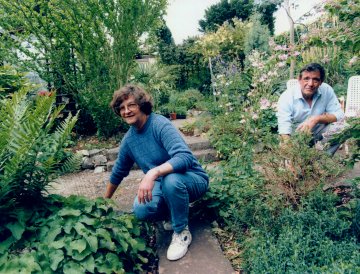 |
Welcome to our garden website. We are Marian and Roger Peacock and
Barum is our house and garden in Clevedon, a small town in North Somerset, UK, 15miles west of
Bristol, on the Severn Estuary.
The garden enables us to enjoy a creative hobby that involves a fair amount of hard work, with the occasional gin to finish the day.
We first opened our the garden in support of the NGS in 1998 (their website lurks behind the logo above).
We took two years off in 2014 and 2015, but returned in 2016 for a final year.
We hope to open this year to support Clevedon Pride (an unfortunate title these days). They usually hold their gardens open over a weekend around mid-June − watch this space. |
Most of the photos on this website hide a larger picture, just click on the pictures.
Clevedon lies on the Severn Estuary in North Somerset with Wales 10 miles across the water.
Our plot sits on a Carboniferous Limestone outcrop, like the Mendip Hills which lie 10 miles to the South-east. Presumably, there was some rock left-over when the building was finished, and it was dumped here!
The Climate
The rainfall is fairly high and occasionally we get snow (aimed at the Welsh hills, but missed).
Wind is also a frequent visitor, and westerlies often whistle up the Bristol Channel. However, since the garden slopes away from the estuary, we are spared the worst of the gales.
This natural protection, enhanced by 8ft beech hedges and the naturally clement maritime climate, give Barum an unusually mild micro-climate.
The lowest temperature we have measured is −8°C, in January 2010.
We have found that many of the "tender" plants survive the Winter in our well-drained soil since their roots do not sit in a cold puddle.
Many plants seem to suffer badly if their growing point is subject to wet-cold, whereas they seem to shrug off dry-cold. This has been discovered by trial and error, by over-wintering many potted plants with top and wind-protection but no cold protection.
We have been recording some weather data over the last few years. These may be perused on the Weather page.
The Soil
The soil is shallow, overlaying the limestone bedrock, and very well-drained. Many wheelbarrow loads of compost and leaf-mould are dug in each year in an attempt to preserve moisture; farmyard manure is not an option as the dog rolls in it to improve the condition of his coat, or consumes it as a dietary supplement.
The soil is less alkaline than one would expect. We suspect this is because we are on top of a hill allowing the Calcium salts to leech away. It is neutral at the top and alkalinity increases down the slope.
Back to Top of Page
Introduction
We moved here in 1991, and found a 1/3 acre garden that had not been touched for 4 years, and the bottom half had not been looked at for at least 10 years.
We hacked our way through the overgrowth and discovered a piece of land that could be restored into a garden. We also discovered several plants that must have been here since the house was built − 1938.
You, dear reader, can enjoy the story of the garden's renovation over the years. This is set out in a set of annual rambles on the "Garden History Page". The most recent activities are separate, these are integrated into the history page annually once they are truly history.
The Planting
The Head Gardener has fully exploited the mild climate and well drained soil to include many unusual and tender plants from many parts of the world.
A fairly complete list, with some pictures can be found at Plant List.
The Garden Sections
The garden naturally separates into sections. NOT "rooms" (these are for eating, sitting, sleeping and drinking gin). The following headings reflects these subdivisions − there is no need to panic about the names used (these things just happen).
This is that part of the plot that stops the house falling into the road. At Barum most of it is used to park cars, but there are a couple of beds.
The first one, by the front wall, houses an Arbutus, a Viburnum bodnantense and a Yucca gloriosa.
The other one was created in 2001, when a path was removed. This now houses 3 Phormium, a Cercis and an old decapitated conifer that now acts as a climbing post for 3 clematis (C. viticella 'Polish Spirit' and C. montana 'Rubens' C 'Rouge Cardinal') and a Rose (Mme Alfred Carriere). Since the conifer is dead we wonder how long it will continue as a support.
Back to Garden Heading
This is the mildest part of the garden, protected by the house and facing SE.
There are 2 patios:
- the first is cluttered with pots all year round − in Summer the conservatory is emptied out here, and in Winter many of the potted half-hardies are placed here for protection.
There is a raised bed, with water feature, planted with many half-hardies.
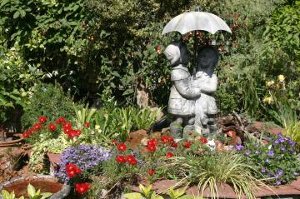 |
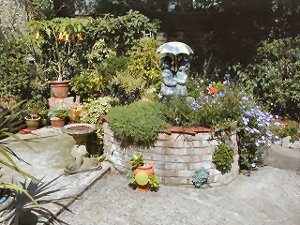 |
The back wall of the house is not let off, being used as a "plant-horse". Here, a Mina lobata is seen scrambling up a Freemontedendron, with a Lophospermum erubescens (the pink flower following up behind). |
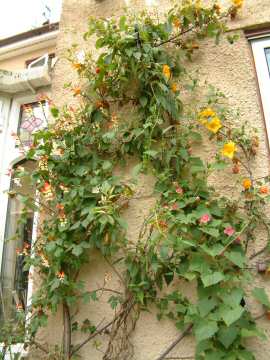 |
- The second has seats (for the very occasional gin), covered by a pergola dripping with climbers: Wisteria, Akebia, Rosa and a Dregea sinensis that exudes a powerful pong on Summer evenings. This provides shade for the couple of sunny days we get each summer.
Back to Garden Heading
This is a lawned area, with beds filled with flowering shrubs. The lawn's function is to provide walking space between the beds. However, it provides the Undergardener with his weekly exercise, when he wanders up and down for about an hour, pushing a lawnmower. Time spent on this prevents him interfering with the Headgardener's schemes.
This is a view of the top garden taken in November 2003, it shows the view from an upstairs window, and shows the garden in its Autumn colour − I chose a good year.
The large red tree towards the bottom of the garden is a Prunus cerasifera 'Pissardii'. This tree had grown prolifically during the last few years, and lost a large bough late in the dry Summer of 2013, we had to remove the crown − more details in the annual report
The tree just peering into the right is an old Acer palmatum. Click for a picture of the Acer, taken on a misty day a couple of weeks later.
|
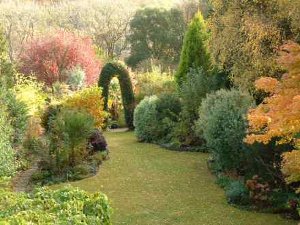 |
A fern bed (fernery) was added in 2003 to a shady area where the soil is at least slightly moist. In the foreground are some annual begonias − which are also likely to survive the winter here.
All the ferns are left out to over-winter: the Dryopteris Wallichiana gets some protection around the roots, and a large clod of leaf-mould thrown over the crown; The Tree Fern (in the blue pot) died during the harsh Winters of 2009 − 2011.
|
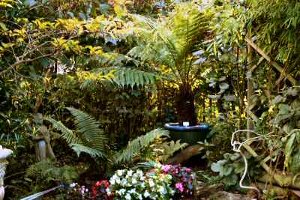 |
This part of the garden is terminated by a row of trellis and an arch.
The trellis was designed and built in house − to ensure the correct length and height. Manufacturing items like this is thrust upon the Undergardener without a second thought.
The arch was created by heaving two Chamaecyparis lawsoniana 'Columnaris' trees together. The individual trees had become unbalanced since one started to grow faster than the other. Another job for the Undergardener − clipping them each year from a dodgy ladder.
Back to Garden Heading
This section consists of a set of beds separated by stone paths. These paths were here when we moved in, but invisible − being completely overgrown. The paths separate ten irregularly shaped beds, each about 3 metres across (each originally housed an apple tree). These allow the plants to be viewed from all aspects.
These beds now contain our main plant collection. The planting includes many species that are normally considered tender or half-hardy.
The greenhouse bed has been through many re-generations, so has demanded its own page.
| The photos here are only glimpses − it is impossible to produce a complete view without a helicopter. Also, the planting is always changing. |
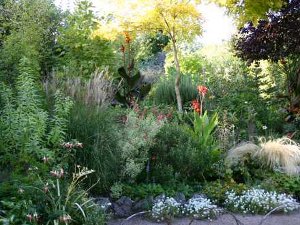 |
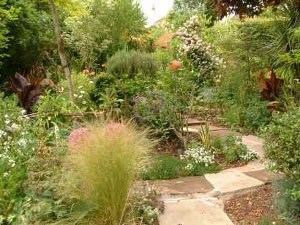 |
Back to Garden Heading
This is the Under Gardeners section, where he is tasked to provide the Headgardener with kitchen produce in accordance with Her demanding standards.
The patch is the only section reviewed annually for cost-effectiveness. This is because it is the most fertile section of the garden, and each year jealous eyes are cast over it as a potential location for Her expansive ambitions. Any saving is instantly claimed for the housekeeping account, and thus claimed by Herself − she must have been a tax inspector in a previous life!
The Undergardener has to report, annually, details of crops planted each year. He has refused to include any financial book-keeping malarkey − She can do that, although none have ever been shown to the Undergardener. These annual reports can be found at "The veg pages".
Back to Garden Heading
This is the bottom section of the garden, and the last to have any development applied.
Originally this section contained a Sophora japonica, some scruffy shrubs and a huge number of weeds.
The Under Gardener has sneakily created some additional beds and adding plants of his choice, without managerial permission. This includes a Crinodendron patagua; a double Deutzia (D scabra 'Plena'); a Catalpa x erubescens 'Purpurea' together with many others.
It also includes a natural section − very trendy. This has been inspired by fashion (mainly idleness) and the chalky dust that counts for soil in this section.
Snowdrops, Primroses, Cowslips, Bluebells and lots of other spring bulbs have established themselves here.
Back to Garden Heading
Back to Top of Page
| Electronic Mail Address :− |
 |



